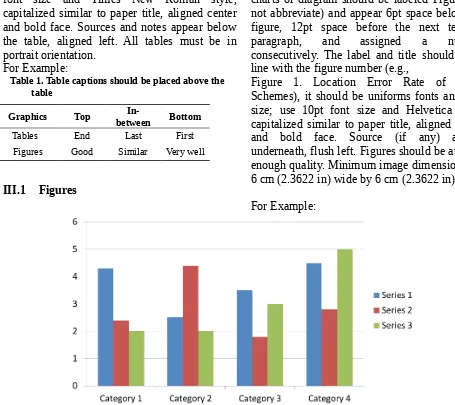JURNAL ARBITRER - VOL. X NO. X (X)
Online version available in : http://arbitrer.fib.unand.ac.id
JURNAL ARBITRER
| 2339-1162 (Print)| 2550-1011 (Online) |
Article
Title No More Than 20 Words
Name of the Author1, Name of the Author2, Name of the Author3
The abstract should summarize the content of the paper. Try to keep the abstract below 200 words. Do not make references nor display equations in the abstract. The journal will be printed from the same-sized copy prepared by you. Your manuscript should be printed on A4 paper (21.0 cm x 29.7 cm). It is imperative that the margins and style described below be adhered to carefully. This will enable us to keep uniformity in the final printed copies of the Journal. Please keep in mind that the manuscript you prepare will be photographed and printed as it is received. Readability of copy is of paramount importance.
KEYWORD
Write, no more, than, five, keywords
KORESPONDENSI
Phone: xxxxxxxxxxx E-mail: author@email.com
INTRODUCTION
The introduction of the paper should explain the nature of the problem, previous work, purpose, and the contribution of the paper. The contents of each section may be provided to understand easily about the paper.
I. METHODS
The methods section describes the rationale for the application of specific procedures or techniques used to identify, select, and analyze information applied to understanding the research problem, thereby, allowing the reader to critically evaluate a study’s overall validity and reliability. The methodology section of a research paper answers two main questions: How was the data collected or generated? And, how was it analyzed? The writing should be direct and precise and always written in the past tense.
II. RESULT
The results section is where you report the findings of your study based upon the particularly necessary if your paper includes data generated from your own research.
Table
Place tables as close as possible to the text they refer to and aligned center. A table is labeled Table and given a number (e.g., Table 1. Sample Datasheet with Attributes in Linguistic Term) it should be numbered consecutively. The table label and caption or title appears 10 pt space above the table, 6 pt
FIRST AUTHOR / JURNAL ARBITRER - VOL. X. NO. X (XXXX)
space after the text or paragraph if any; it should be uniforms fonts and font size, and use 11pt font size and Times New Roman style, capitalized similar to paper title, aligned center and bold face. Sources and notes appear below the table, aligned left. All tables must be in portrait orientation.
For Example:
Table 1. Table captions should be placed above the table
Graphics Top betweenIn- Bottom
Tables End Last First
Figures Good Similar Very well
III.1 Figures
Place figures as close as possible to the text they refer to and aligned center. Photos, graphs, charts or diagram should be labeled Figure (do not abbreviate) and appear 6pt space below the figure, 12pt space before the next text or paragraph, and assigned a number consecutively. The label and title should be in line with the figure number (e.g.,
Figure 1. Location Error Rate of Three Schemes), it should be uniforms fonts and font size; use 10pt font size and Helvetica style, capitalized similar to paper title, aligned center and bold face. Source (if any) appear underneath, flush left. Figures should be at good enough quality. Minimum image dimensions are 6 cm (2.3622 in) wide by 6 cm (2.3622 in) high.
For Example:
Fig 1: If necessary, the images can be extended both columns (10 Bold)
III. DISCUSSION
The purpose of the discussion is to interpret and describe the significance of your findings in light of what was already known about the research problem being investigated, and to explain any new understanding or insights about the problem after you've taken the findings into consideration. The discussion will always connect to the introduction by way of the research questions or hypotheses you posed and the literature you reviewed, but it does not simply repeat or rearrange the introduction; the discussion should always explain how your study has moved the reader's understanding of
the research problem forward from where you left them at the end of the introduction.
IV. CONCLUSION
The conclusion is intended to help the reader understand why your research should matter to them after they have finished reading the paper. A conclusion is not merely a summary of the main topics covered or a re-statement of your research problem, but a synthesis of key points and, if applicable, where you recommend new areas for future research. For most essays, one well-developed paragraph is sufficient for a
FIRST AUTHOR / JURNAL ARBITRER - VOL. X. NO. X (XXXX)
conclusion, although in some cases, a two or three paragraph conclusion may be required
REFERENCES A. A. Name, and B. B. Name, Book Title, Place: Press, Year.
A. Name, and B. Name, "Journal Paper Title", Journal Name, Vol. X, No. X, Year, pp. xxx-xxx. A. Name, "Dissertation Title", M.S.(or Ph.D.) thesis, Department, University, City, Country, Year. A. A. Name, "Conference Paper Title", in Conference Name, Year, Vol. x, pp. xxx-xxx.
BIOGRAPHY
First Author Biographies should be limited to one paragraph consisting of the following:
sequentially ordered list of degrees, including years achieved; sequentially ordered places of employ concluding with current employment; association with any official journals or conferences; major professional and/or academic achievements, i.e., best paper awards, research grants, etc.; any publication information (number of papers and titles of books published); current research interests; association with any professional associations. Do not specify email address here.
Second Author biography appears here. Degrees achieved followed by current employment are
listed, plus any major academic achievements. Do not specify email address here.
Third Author biography appears here. Do not specify email address here.
